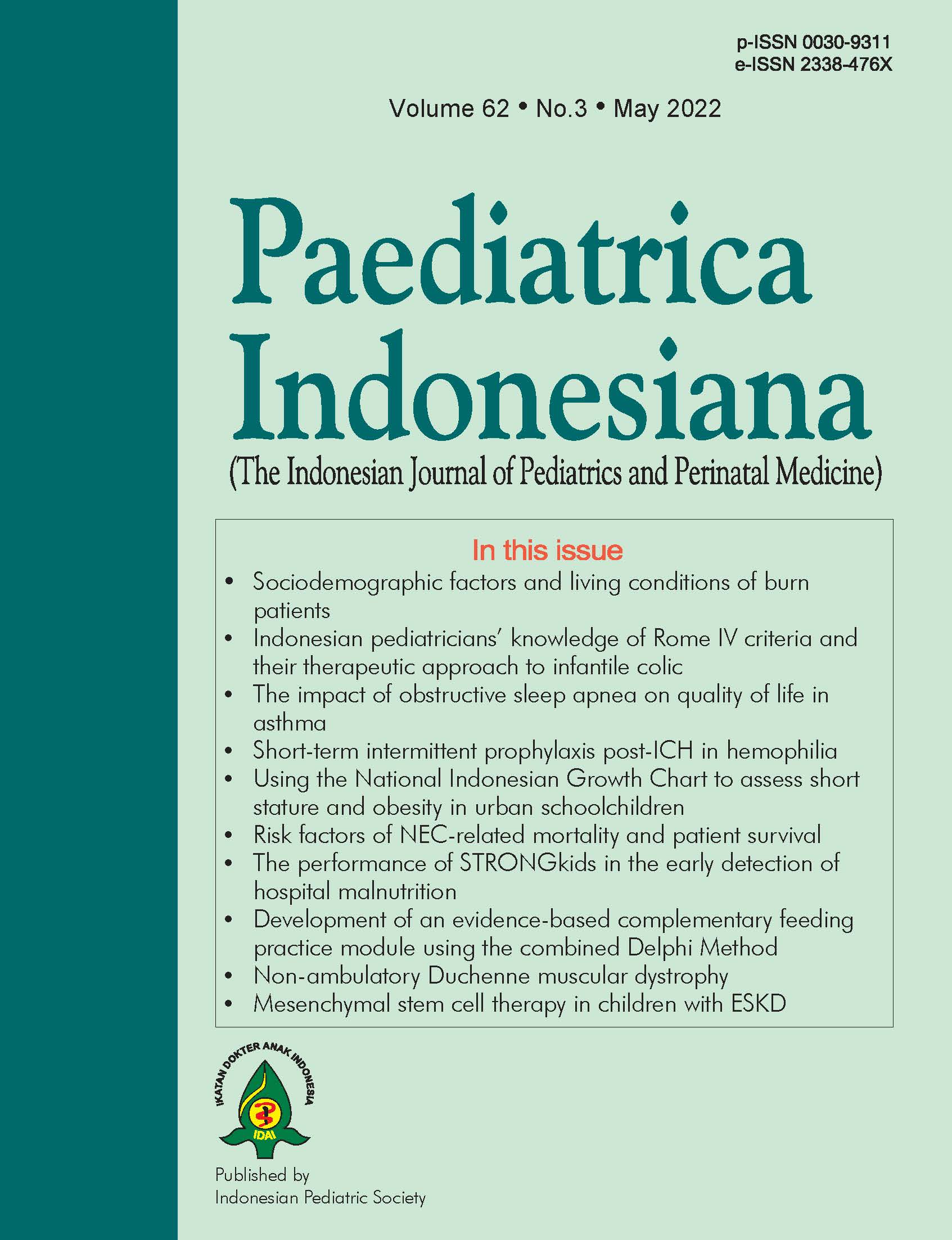Using the National Indonesian Growth Chart to assess short stature and obesity in urban schoolchildren in Surakarta, Indonesia: comparisons to the WHO 2007 and CDC 2000 Growth Charts
Abstract
Background The National Indonesian Growth Chart (NIGC) is a new growth chart based on Indonesian population data. To date, the CDC 2000 or WHO 2007 charts have been widely used in Indonesia to assess the growth of 5-to-18-year-old children. Use of these reference charts may lead to inaccurate conclusions about children’s nutritional status, particularly when diagnosing short stature or obesity.
Objective To compare assessments of short stature and obesity in Indonesian urban schoolchildren and adolescents based on CDC, WHO, and NIGC reference charts.
Methods Pooled anthropometric data [height, weight, and body mass index (BMI)] were collected cross-sectionally from healthy schoolchildren aged 6 to 18 years in Surakarta in 2013, 2016, 2018, and 2019. We created scatterplots for height, weight, and BMI and analyzed differences in height-for-age (HAZ) and BMI (BAZ) z-scores according to the CDC, WHO, and NIGC growth charts, then calculated differences in proportions of children identified as having short stature or obesity.
Results We included 2,582 subjects; 63% were girls. Subjects’ mean age was 13.1 (SD 3.4) years. Mean differences in HAZ between the NIGC vs. CDC chart and NIGC vs. WHO chart were 1.44 (SD 0.01) and 1.39 (SD 0.00), respectively. Mean differences in BAZ between the NIGC vs. CDC chart and NIGC vs. WHO chart were 0.18 (SD 0.01) and 0.06 (SD 0.01), respectively. The prevalence of short stature was 9.91%, 11.62%, and 0.39% according to the WHO, CDC, and NIGC charts, respectively. The prevalence of obesity was 10.15%, 5.07%, and 11.77% according to the WHO, CDC, and NIGC charts, respectively. The prevalence of obesity according to the WHO, CDC, and NIGC was 7.44%, 2.95%, and 10.08%, respectively in girls and 14.76%, 8.69%, and 14.66%, respectively in boys.
Conclusion The use of the NIGC resulted in a lower prevalence of short stature compared to the CDC or WHO charts. Compared to the WHO charts, the NIGC gave a similar prevalence of obesity overall and in boys, but a higher prevalence of obesity in girls. Compared to the CDC charts, the NIGC gave a higher prevalence of obesity both in boys and girls.
References
2. Kelishadi R, Heidari-Beni M, Azizi-Soleiman F, et al. Reference curves of anthropometric indices in two national studies conducted among Iranian children in 2003-2004 and 2009-2010: the Caspian study. J Res Med Sci. 2014;19:709-14. PMID: 25422654.
3. Pulungan AB. Auxology, kurva pertumbuhan, antropometri, dan pemantauan pertumbuhan. Sari Pediatr. 2020;22:123-30. DOI: https://doi.org/10.14238/sp22.2.2020.123-30
4. de Onis M, Onyango AW, Borghi E, Siyam A, Nishidaa C, Siekmann J. Development of a WHO growth reference for school-aged children and adolescents. Bull World Health Organ. 2007;85:660-7.
5. Pulungan AB, Julia M, Batubara JR, Hermanussen M. Indonesian national synthetic growth charts. Acta Sci Paediatr. 2018;1:20-34. Available from: https://www.actascientific.com/ASPE/pdf/ASPE-01-0006.pdf.
6. Hong SA, Mongkolchati A, Chompikul J, Mo-Suwan L, Choprapawon C. Comparison of prevalence of nutritional status of Thai children in the first two years of life using national and international growth charts. J Med Assoc Thail. 2016;99:58-64. PMID: 2745582.
7. Moelyo AG, Yogasatria L, Setyawan YA, Rokhayati E. Sitting height, sitting height/height ratio, arm span, and arm span-height differences of healthy adolescents. Paediatr Indones. 2018;58:138-145. DOI: https://doi.org/10.14238/pi58.3.2018.138-45.
8. Centers for Disease Control and Prevention NC for HS. CDC growth charts. http://www.cdc.gov/growthcharts/. Published 2000. Accessed April 17, 2022.
9. de Onis M, Branca F. Childhood stunting: A global perspective. Matern Child Nutr. 2016;12:12-26. DOI: https://doi.org/10.1111/mcn.12231
10. CDC. Anthropometry Procedures Manual. NHANES. 2016;(January):1-120. Available from: https://www.cdc.gov/nchs/data/nhanes/nhanes_15_16/2016_Anthropometry_Procedures_Manual.pdf
11. Novina N, Hermanussen M, Scheffler C, Pulungan AB, Ismiarto YD, Andriyana Y, et al. Indonesian National Growth Reference Charts better reflect height and weight of children in West Java, Indonesia, than WHO child growth standards. J Clin Res Pediatr Endocrinol. 2020;12:410-9.
12. Flynn J, Alkaff FF, Sukmajaya WP, Salamah S. Comparison of WHO growth standard and national Indonesian growth reference in determining prevalence and determinants of stunting and underweight in children under five: a cross-sectional study from Musi sub-district. F1000Research. 2020;9:324. DOI: https://doi.org/10.12688/f1000research.23156.4.
13. Bong Y, Shariff AA, Mohamed AM, Merican AF. Malaysian growth centiles for children under six years old. Ann Hum Biol. 2015;42:108-15. DOI: https://doi.org/10.3109/03014460.2014.912679.
14. Yang Z, Duan Y, Ma G, Yang X, Yin S. Comparison of the China growth charts with the WHO growth standards in assessing malnutrition of children. BMJ Open. 2015;5:e006107. DOI: https://doi.org/10.1136/bmjopen-2014-006107.
15. Marceau K, Ram N, Houts RM, Grimm KJ, Susman EJ. Individual differences in boys’ and girls’ timing and tempo of puberty: modeling development with nonlinear growth models. Dev Psychol. 2011;47:1389-1409. DOI: https://doi.org/10.1037/a0023838.
16. Nurwanti E, Hadi H, Chang JS, Chao JC, Paramashanti BA, Gittlesohn J, et al. Rural–urban differences in dietary behavior and obesity: results of the Riskesdas study in 10–18-year-old Indonesian children and adolescents. Nutrients. 2019;11:2813. DOI: https://doi.org/10.3390/nu11112813.
Copyright (c) 2022 Annang Giri Moelyo, Dewinda Candrarukmi, Ulfa Puspita Rachma

This work is licensed under a Creative Commons Attribution-NonCommercial-ShareAlike 4.0 International License.
Authors who publish with this journal agree to the following terms:
Authors retain copyright and grant the journal right of first publication with the work simultaneously licensed under a Creative Commons Attribution License that allows others to share the work with an acknowledgement of the work's authorship and initial publication in this journal.
Authors are able to enter into separate, additional contractual arrangements for the non-exclusive distribution of the journal's published version of the work (e.g., post it to an institutional repository or publish it in a book), with an acknowledgement of its initial publication in this journal.
Accepted 2022-06-27
Published 2022-06-27













